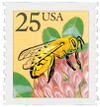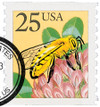
# 2281 - 1988 25c Honeybee, coil
U.S. #2281
1988 25¢ Honeybee, coil
- First US combination-process coil – first coil stamp printed by two totally different procedures.
Stamp Category: Definitive
Value: 25¢, first-class rate
First Day of Issue: September 2, 1988
First Day City: Omaha, Nebraska
Quantity Issued: 2,206,060,000
Printed by: Bureau of Engraving and Printing
Printing Method: Lithographed and Engraved
Format: Coils of 100 and 3,000
Perforations: 10 Vertical
Why the stamp was issued: The stamp pictures a honeybee. Years earlier, in 1980, the USPS had issued a 15¢ stamped envelope picturing a honeybee with a pair of orange blossoms (#U599). However, the light color of the printing on the white envelope was barely visible and many bee enthusiasts were disappointed. The 1988 definitive was the USPS’s chance to redeem themselves. And they did by making it a special issue.
About the stamp design: This was Chuck Ripper’s 69th stamp design. His gouache painting pictures a honeybee on a red clover with green leaves. Ripper had produced hundreds of wildlife paintings in his life, but this was the first to focus on a bee. He worked from photographs, but found there weren’t many good photos of bees. Ripper said if only he had another month to work on it, he could take photos of bees in his own backyard to work from.
About the printing process: This stamp was the USPS’s first combination-process coil, printed by two different procedures at the Bureau of Engraving and Printing (BEP).
The stamp printing began on the BEP’s Goebel Optiforma press. This press printed all the color portions of the design. The stamp rolls were then taken to the C press, which printed the black intaglio and then applied the phosphorescent tagging. Finally, the stamps were perforated and cut into coils for sale.
The USPS had already been using the D Press, which could do offset and intaglio printing as well as phosphor tagging all in one machine. However, the bee stamp was the first coil printed using these multiple presses. Later issues of the stamp were also printed on the D Press.
First Day City: The stamp was first announced on April 4, with an issue date of June 11. Later in April though, the USPS announced that the issue would be delayed because they wanted to make sure they could produce the stamps properly in large numbers to meet demand.
Eventually, the stamps were issued on September 2, 1988, at the Omaha Stamp Show in Nebraska. The issue of these stamps was part of the opening ceremony for the show. After the first day ceremony, the postmaster general cut a strip of honeybee stamps to mark the official opening of the show.
Unusual facts about this stamp: There was a small controversy surrounding these stamps and the BEP. Normally the BEP would send a letter to its employees for a job well done. However, in this case, they produced about 80 souvenir cards for their employees that read, “In commemoration of those employees of the Bureau of Engraving and Printing, whose shear (sic) brilliance, dedication, steadfastness, innovativeness, and technical know-how made ‘Project Honeybee’ a success. The Bureau salutes you.” When collectors learned of these cards, they complained that they were collectible souvenirs that hadn’t been made available to the public. Over the years, some have found their way into collector’s hands, and some were even affixed with the honeybee stamp and canceled on the first day of issue.
Some varieties and errors of this stamp exist: misregistered plate numbers – some which were printed entirely inside the stamp design, several tagging variations, color lines in the perforations, and imperforate errors.
History the stamp represents: In the 1600s, European settlers brought their bees with them to America to pollinate clover for their farm animals and provide honey. The industrious insects continue to produce about 50 pounds of honey per hive each year. The honeybee’s role in pollinating many different crops, trees, and grasses is an important part of the cycle of nature. As bees travel from flower to flower collecting nectar to make honey, they also pick up pollen. On each plant, they leave behind bits of pollen which fertilize the plant, allowing for new growth.
The three types of bees that can be found in a hive are the queen, drone, and worker. The queen bee is selected when she is just two days old. The only sexually developed female in the hive, the queen mates with about 18 drone (male) bees so she can produce eggs in about 10 days (up to 3,000 eggs in one day). Drones are male bees whose only purpose is to mate with the queen. Workers are undeveloped female bees that feed the queen and larvae, guard the hive, and collect nectar.
U.S. #2281
1988 25¢ Honeybee, coil
- First US combination-process coil – first coil stamp printed by two totally different procedures.
Stamp Category: Definitive
Value: 25¢, first-class rate
First Day of Issue: September 2, 1988
First Day City: Omaha, Nebraska
Quantity Issued: 2,206,060,000
Printed by: Bureau of Engraving and Printing
Printing Method: Lithographed and Engraved
Format: Coils of 100 and 3,000
Perforations: 10 Vertical
Why the stamp was issued: The stamp pictures a honeybee. Years earlier, in 1980, the USPS had issued a 15¢ stamped envelope picturing a honeybee with a pair of orange blossoms (#U599). However, the light color of the printing on the white envelope was barely visible and many bee enthusiasts were disappointed. The 1988 definitive was the USPS’s chance to redeem themselves. And they did by making it a special issue.
About the stamp design: This was Chuck Ripper’s 69th stamp design. His gouache painting pictures a honeybee on a red clover with green leaves. Ripper had produced hundreds of wildlife paintings in his life, but this was the first to focus on a bee. He worked from photographs, but found there weren’t many good photos of bees. Ripper said if only he had another month to work on it, he could take photos of bees in his own backyard to work from.
About the printing process: This stamp was the USPS’s first combination-process coil, printed by two different procedures at the Bureau of Engraving and Printing (BEP).
The stamp printing began on the BEP’s Goebel Optiforma press. This press printed all the color portions of the design. The stamp rolls were then taken to the C press, which printed the black intaglio and then applied the phosphorescent tagging. Finally, the stamps were perforated and cut into coils for sale.
The USPS had already been using the D Press, which could do offset and intaglio printing as well as phosphor tagging all in one machine. However, the bee stamp was the first coil printed using these multiple presses. Later issues of the stamp were also printed on the D Press.
First Day City: The stamp was first announced on April 4, with an issue date of June 11. Later in April though, the USPS announced that the issue would be delayed because they wanted to make sure they could produce the stamps properly in large numbers to meet demand.
Eventually, the stamps were issued on September 2, 1988, at the Omaha Stamp Show in Nebraska. The issue of these stamps was part of the opening ceremony for the show. After the first day ceremony, the postmaster general cut a strip of honeybee stamps to mark the official opening of the show.
Unusual facts about this stamp: There was a small controversy surrounding these stamps and the BEP. Normally the BEP would send a letter to its employees for a job well done. However, in this case, they produced about 80 souvenir cards for their employees that read, “In commemoration of those employees of the Bureau of Engraving and Printing, whose shear (sic) brilliance, dedication, steadfastness, innovativeness, and technical know-how made ‘Project Honeybee’ a success. The Bureau salutes you.” When collectors learned of these cards, they complained that they were collectible souvenirs that hadn’t been made available to the public. Over the years, some have found their way into collector’s hands, and some were even affixed with the honeybee stamp and canceled on the first day of issue.
Some varieties and errors of this stamp exist: misregistered plate numbers – some which were printed entirely inside the stamp design, several tagging variations, color lines in the perforations, and imperforate errors.
History the stamp represents: In the 1600s, European settlers brought their bees with them to America to pollinate clover for their farm animals and provide honey. The industrious insects continue to produce about 50 pounds of honey per hive each year. The honeybee’s role in pollinating many different crops, trees, and grasses is an important part of the cycle of nature. As bees travel from flower to flower collecting nectar to make honey, they also pick up pollen. On each plant, they leave behind bits of pollen which fertilize the plant, allowing for new growth.
The three types of bees that can be found in a hive are the queen, drone, and worker. The queen bee is selected when she is just two days old. The only sexually developed female in the hive, the queen mates with about 18 drone (male) bees so she can produce eggs in about 10 days (up to 3,000 eggs in one day). Drones are male bees whose only purpose is to mate with the queen. Workers are undeveloped female bees that feed the queen and larvae, guard the hive, and collect nectar.










